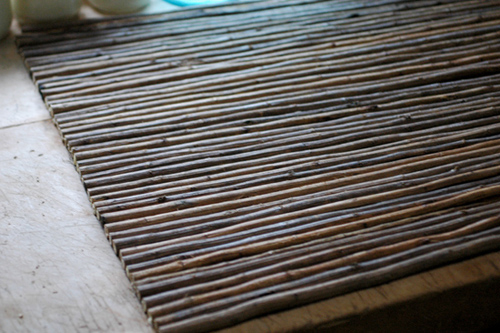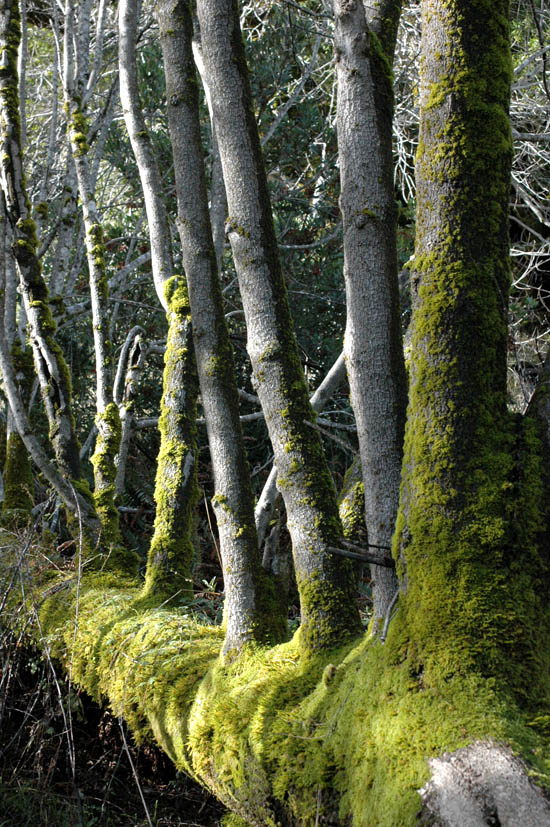By: Steven Edholm
Need straighter, longer, or more evenly tapered sticks? Who doesn’t? It’s not always easy to find a nice stick when you need one. We might have plans for certain types of sticks, but nature has priorities other than providing us with them, and doesn't necessarily have the same criteria for "better sticks" as we do. Knowing where to look for straight wood, and how to manage plants for the production of such, is essential knowledge in the paleo arts. Now that it's winter, it's time to harvest twigs and sticks for our baskets and hand drills and things like that, so I thought a post on the subject would be appropriate.
What we're looking for: More uniform than average twigs, sticks and staves find many uses. Arrows, hoops, spears, hand drill shafts, basketry elements and bowstaves are some classic examples. There are several characteristics that we are commonly looking for in sticks for making stuff:
Straight (or at least with long gentle curves instead of short sharp bends)
Free of branches
Gradually tapering (i.e. not a very different diameter at the top and bottom)
Long (of course that’s relative)
We may need only one or two of these characteristics, but we would often like to find them all in the same stick.
Nascent v.s. mature growth: Some trees and shrubs grow naturally straight and branch free, but the norm is various degrees of curved, zig zagging and short jointed branches growing in all directions. Many species do however have the capability of growing straight given the proper stimulus, resources, and conditions.
When trees and shrubs grow from seed, they get off to a slow start. Each year, the seedling root system gets bigger foraging nutrients and water underground and storing some of those resources for spring growth. A few seedlings luck out and get the best spot ever, growing rapidly upward, but growth in seedlings is slow as a rule.
Even with the resources gathered by a large root system, more mature trees and shrubs typically grow slower with short joints and crooked branches. This is largely due to the fact that there are so many branches competing for those resources. The growth of a plant is largely determined by competition with itself. If we reduce competition, we can channel an abundance of growth energy into fewer growing points- enter nascent growth...
Nascent growth is fast vigorous growth. The defining factor is that is has access to resources for rapid extension of the shoot during the growing season. There can be numerous reasons that the shoot has access to the food and water needed for rapid growth.
One way the shoot may gain advantage in the structure of the tree is by it’s placement relative to the physiology of the tree. The shoots known as water sprouts, or suckers, on fruit trees are a good example that many people are familiar with. Hormones within the tree can suppress or encourage growth and the water sprout has managed to bypass the growth suppression hormones taking a large share of food for it’s growth.
Conditions conducive to nascent growth: Dormant buds can be stimulated to grow by a change in the position of the branch or trunk. The tips of branches and trees usually send growth suppressing hormones down to stunt growth of lower branches, while continuing to grow taller themselves. This phenomenon for the sciencey among you is called Apical Dominance. Lower branches, guided by hormones from above, make less vegetative growth and typically do the work of reproduction, producing flowers, fruits and seeds. If the position of the branch changes, say if a trunk falls over to a horizontal position, or a branch is bowed down heavily by snow, is bent low by a heavy fruit load or is pinned down by a fallen tree, the buds along the top of the branch are now higher than the other buds on the branch. No longer receiving the “no grow” hormonal message from above, they grow like crazy often causing a mass of long straight shoots reaching for the sky.
Aside from fallen trees and bent down branches, we can look to some other natural phenomena for opportunities to gather nascent shoots. Fires and floods can provide these opportunities. Natural fires are common in many areas and not uncommon in most. As a result many plants are fire adapted. When they are burned over, most trees and shrubs can sprout back and grow new structures from their well established root systems. After a fire, the root resources that supported the whole plant are now channeled into fewer shoots causing them to grow rapidly to compete for light and outgrow predators. It is in the best interest of the plant to reach a mature stature and begin reproducing as quickly as possible.
Floods provide a similar effect by damaging the above ground portions of plants, though often the shoots will grow in response the plant having been bent over by flood waters rather than torn away. Plants that grow along river banks and sandbars are well adapted to flooding and usually produce copious shoots after a high water winter.
Practices for encouraging nascent growth: Practices for managing plant growth are used the world over in traditional cultures and must stretch very far back into the past. It should be no surprise as it is easy enough to put two and two together when observing natural phenomena. Now that we know some phenomena that cause nascent growth, we can use management practices to encourage shoots when and where we want them.
Coppicing and pollarding are practices in which the plant is cut back very hard during the dormant season, removing all growth since the last harvest. The only difference between a coppice and a pollard is that in pollarding a trunk and/or a branchlike tree structure is maintained but headed off at the same point periodically, while coppiced plants are cut at ground level. Some plants that coppice well, such as willow and osier dogwoods, can be cut to the ground every year for basketry material without suffering any setback, though they are sometimes cut on a multi-year cycle to produce larger material for fencing, fuel, timber or other uses.
Plants can also be burned to the ground to stimulate new growth. This is nothing more than coppicing by fire.
One last method I’ll leave you with is bending. One way to farm shoots on some plants is to bend tall shoots over to a horizontal position, or better yet in a bow shape with the tips lower than the top of the bow. In some plants new growth will sprout up along the bent branch. If the branch is high enough the shoots can have an advantage in outgrowing browsing animals like deer. Browsing could shorten your shoots or cause them to branch or have crooks. I've been told that this method was used to produce arrow shafts of Mock Orange by Indians in Northwest California, but haven't had an opportunity to try it.
How plants grow: There are many factors to consider when deciding what to cut and when, such as population density, make up of the forest, management goals, human use and infrastructure, what animals depend on the plant for their living and so on. Possibly of greatest importance is to know how a particular species grows before you start chopping it down to make sticks. Most plants will sprout readily from the base, but some will not grow back when cut down. Others may sprout back, but will not tolerate continual annual coppicing. Careful observation of natural and human damage to trees and shrubs and their response over time will usually give you the clues you need to get started. Road crews regularly coppice trees and shrubs along roadsides providing useful materials as well as clues to plant responses to coppicing. Recently logged or burned areas are other places to start looking at plant regrowth patterns. It is generally best to cut near the dormant season, anywhere from when the plant growth stops in the fall, to soon after it begins again in the spring.
Given our seeming distance from nature in modern society, it is easy to view cutting down trees and shrubs as inherently negative, as if nature sorts itself out perfectly, but this is not so. Human harvesting and management practices can have both positive and negative effects. Often the effect may be negative for one aspect of the ecology and positive for another... in other words, just different, or possibly more accurately an issue of perspective and values. It is especially true when dealing with logged over land (which is virtually all that is left to us) that some human intervention can have an effect which would be hard to argue as other than positive. These decisions require some knowledge to be effective and we all have a lot of homework and observation to do in order to earn an honorable place in the scheme of things. Natural systems are typically tough and chaotic environments and therefore they and their citizens are for the most part fortuitously resilient. This resilience is amply evidenced by the phenomenon of nascent growth.
A Quick RECAP!
*Straighter, branch free, evenly tapering, long and otherwise more uniform sticks are commonly needed in the paleo arts.
*Many plants are evolved to recover quickly from damage growing up straight and fast. This quick new growth is known as nascent growth.
*Natural phenomenon such as fires, flooding or wind storms can provide opportunities for the harvest of Nascent shoots and trunks.
*Coppicing (cutting to the ground) and Pollarding (cutting higher up on the trunk) are common pandemic practices for cultivating nice sticks.
*Knowing how a particular species grows, and how it fits into the local ecology can keep us from making management mistakes. Plants at all stages of growth help provide this information if we pay attention.
For more information and philosophy on sustainable harvest practice see Paleotechnics bulletin #1: Sustainable Harvest: approaching wildcrafting with knowledge and intent .










